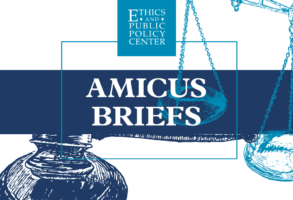
Published March 15, 2024
Since its creation more than six decades ago by Frank Meyer and his associates, “fusionism” has enjoyed both a glittering track record of political success and a dismal legacy of failure. As a political movement, it scored some remarkable electoral successes, and helped the Republican Party, seemingly stuck in perpetual minority status, achieve parity in national politics and build a formidable majority of statehouses and governorships. Fusionism can also, more indirectly, claim credit for many of the very real conservative victories in the courts in the past generation. These achievements deserve the respect and appreciation of younger conservatives today, who are so often tempted (in very un-conservative fashion) to mock their elders and forebears for their political and ideological missteps. “Let not him who straps on his armor boast like him who takes it off,” runs the wonderful proverb from the Hebrew Bible. Until today’s NatCons or “realignment conservatives” can boast a long record of political successes, they should be slow to pooh-pooh those who can.
And yet there is no denying that America is a much more divided, much more depressed, and much less conservative place than forty years ago. Ronald Reagan’s “morning in America” may have dawned bright and clear after the strife of the 60s and the doldrums of the 70s, but it proved short-lived. We live in an era where leading “conservative” pundits are publicly cheered on by their comrades for announcing they’ve successfully rented the womb of a random woman in order to produce a child for their gay union. We are living downstream of a quarter century in which both political parties completely abdicated any oversight of emerging digital technologies that have unleashed an epidemic of pornography and sexual exploitation, of isolation and teen suicides, and a regime of casually ubiquitous surveillance that puts Stalin to shame. Fusionism must bear at least some of the “credit” for these developments as well.
The idea behind fusionism was simple: most Americans didn’t want state socialism, but it would advance steadily as long as its enemies were politically divided. Some of those enemies didn’t like socialism because it was godless and destructive of traditional virtue, while others didn’t like socialism because it told individuals what to do, destroying their “liberty.” At first glance, it’s no wonder these two groups of anti-socialists were divided, for their views seemed mutually exclusive. Libertarians saw conservatives, like socialists, as repressive of individual liberty; while conservatives saw libertarians, like socialists, as dissolving the all-important fibers of traditional morality. All they could agree on was that the bureaucratic state was growing too large and needed to be restrained.
To be sure, there were some very concrete areas of policy agreement. For instance, both conservatives and libertarians prized the institution of private property. The former embraced property as a means of nurturing a virtuous citizenry, the latter embraced it as a sphere of individual autonomy. Such overlaps are the stuff of which successful political coalitions are built, and if that is all that fusionism was meant to be, then three cheers for it. Political coalitions are essential features of politics. People may not see eye-to-eye on many things, but they may at least agree to pursue certain goods or remove certain obstacles. Even in the game of Risk, shrewd players know how to temporarily set aside their differences to cut a powerful third player down to size. The Left’s strategy in 2020 was a case in point: you didn’t need to agree on much besides an opposition to Trump. Indeed, the Democratic Party is a master of coalition-building, with its longstanding alliance of socially conservative Blacks and hyper-progressive whites showing few signs of cracking.
If fusionism was just a political coalition, then, it served an indispensable role in restraining Marxism in the ‘60s-‘80s, and may continue to serve an indispensable role in combatting new forms of Marxism today. But fusionism, as its very name suggests, aims to be much more than a coalition or pragmatic cobelligerency. It aims to be an ideological synthesis, a fusion of ideas. But this is sheer confusion.
Consider a case of two social workers, one a traditionalist who believes that every child should have the privilege of being raised in a stable home with a married mother and father, the other a rabid libertarian who thinks children should be given maximal space to express their own autonomy. Both will agree that children should not be physically abused, but for one this will be because such abuse represents a tyrannical distortion of the good of parental authority; for the other, because parental authority is no good at all. Confronted with a case of unambiguous ongoing child abuse, both will lose little time in being able to collaborate on the task of getting the poor child out of the abusive environment. But since they will not agree on why they are doing so, they will not agree about what to do next. Nor will they be able to agree on more borderline cases—for instance, is any use of corporal punishment to be deemed abusive?
So it is with resisting an overreaching civil government. Intellectually speaking, there is all the difference in the world between opposing an action because it represents an abuse of a true and legitimate authority and opposing that action because the agent has no authority. Practically speaking, the two oppositions may look the same, and make common cause, for a time—but only up to the point where, to the conservative, the proper balance has been re-established. Otherwise, we will find ourselves like “the famous Irishman” referenced by C.S. Lewis, “who found that a certain kind of stove reduced his fuel bill by half and thence concluded that two stoves of the same kind would enable him to warm his house with no fuel at all.” The conservative knows that exercises of power must be limited up to a point, and no further. He may certainly collaborate with those who want the power eliminated altogether, but he had better do so with his eyes wide open to the underlying differences.
Still, the fusionist may object that I am straw-manning. The kind of libertarianism that Frank Meyer sought to harness to conservatism was not the radical libertarianism that sees liberty and autonomy as ends in themselves. Meyer insisted that he as much as Russell Kirk, or Aristotle for that matter, thought virtue the true end of a well-lived human life. Liberty was a purely instrumental good, with a negative role in clearing space for the pursuit of virtue in its proper sphere: the private realm. Since virtue cannot be coerced, and the state cannot do anything but coerce, it followed as a matter of simple logic that state power must be limited if individuals were to pursue and achieve virtue. Fusionism, on this account, was more than mere cobelligerency; it represented a real meeting of the minds about the relationship between liberty, government, and virtue. But did it, really? Here, too, fusionism turns out to rest on sheer confusion.
In his essay, “In Defense of Liberty,” Meyer tips his hand: “Since this institution must possess a monopoly of legal physical force, to give to it in addition any further power is fraught with danger.” The definition of the state as the “monopoly of legal physical force” is of course Max Weber’s, and it has exercised a remarkable spell over the modern imagination. It is one of those statements that deceptively confuses the distinctive feature of a thing with the essence of that thing. It is true that modern states do have such a monopoly, and that makes them unique, but that is one of their less interesting features.
The fact is that only dysfunctional governments exercise most of their authority through coercive physical force. In fact, we may go further and say that governments reliant on coercive physical force do not have authority at all, only power. In most well-functioning states, the government functions because it carries the representative authority of the community; it is seen to embody the norms and expectations of the community, such that one cannot oppose it without in some sense opposing oneself. Of course, in this the state is not unique; the same is true of representative authorities in other settings: businesses, churches, schools, families.
To recognize this, of course, is to immediately blur the simple distinction between “public” and “private” that libertarians and fusionists want to draw. We cannot pursue virtue simply in private, as private individuals or associations, because man is a political animal. We learn virtue in community, we seek to exercise virtue in community, and we want to see virtue embodied, enacted, and promoted in our communities. Now of course one may immediately protest that all this language of “community” has little in common with the modern centralized bureaucratic state, and that is a fair critique—but that is a classical conservative critique, one articulated eloquently by Burke and many others. The nation or state is meant to be a community of communities, not simply a giant policeman, and as such, it must regulate the full range of human affairs. Not in a heavy-handed way, to be sure—the principle of subsidiarity must be paramount—but we cannot exclude a priori any matter that touches the common good from its consideration.
But why should the state need such supervisory powers? Why not simply leave individuals to pursue their own ends (excepting, of course, when they harm one another)? The answer to this question separates the realism of conservatism from the delusional fantasyland of the libertarian. For just as it is the case that the state exercises other forms of influence besides physical coercion, it is equally the case that other communities may constrain or compel without it. John Stuart Mill understood this clearly:
Protection … against the tyranny of the magistrate is not enough: there needs protection against the tyranny of the prevailing opinion and feeling; against the tendency of society to impose, by other means than civil penalties, its own ideas and practices as rules of conduct on those who dissent from them; to fetter the development, and, if possible, prevent the formation, of any individuality not in harmony with its ways, and compel all characters to fashion themselves upon the model of its own.
Such a warning is extremely timely in the age of wokeism, which has certainly made use of the apparatus of the state, but more often exercises its vice-like grip on the body politic through a hundred more subtle and diffuse forms of social and economic power. Against such power, fusionism has no clear answer except to demand that public governmental institutions assume a posture of studious neutrality in relation to the new morality. From their standpoint, Florida Governor Ron DeSantis’s aggressive pro-family countermeasures in Florida are every bit as heretical as some DEI directive emanating from the Portland Politburo. The fusionist’s strict public-private distinction turns out to be completely arbitrary, at least if the goal is protecting individual freedom; for the institutions of “the private sphere” are extraordinary accomplished in the business of limiting individual liberty.
But of course, the flipside of this is also true. If virtue, not liberty, is the end goal, then it ends up looking very arbitrary to insist that virtue may be cultivated by the extremely powerful social pressure of families, churches, and schools but never by the social pressure of laws. The traditional conservative takes a wide-angle view, recognizing that liberty and authority always stand in a delicately balanced, dynamic tension, one shaped by a host of communities and institutional contexts, and that the proper limits of formal government authority must be determined on a prudential case-by-case basis, not by some a priori line in the sand.
What, then, does all this mean for fusionism today? Well, again, it all depends on what we are asking fusionism to be and to do for us. It certainly still has a valuable role to play if honest about its limited role as a form of political collaboration. American society comprises an almost impossibly diverse spectrum of views, both on the question of what the public morality should be, and on the extent to which law should seek to inscribe that morality. In such a situation, political success will rest only with that movement capable of successfully forging and leveraging a diverse coalition. If transgender surgeries on twelve-year-olds can be prevented by a coalition of those who believe biological sex is an immutable God-given norm, and those who just think twelve-year-olds are not yet fully autonomous rational agents, well and good.
We must be clear about what we are doing in such cases. We must not mistake political cobelligerency for intellectual synthesis. If we do, the more traditionalist elements of the coalition are likely to undercut their own cause, as they have done countless times in the past fifty years. The response to COVID-19 was a case in point. Here, there was an opportunity for fruitful coalition between traditional conservatives who considered public health a public good, but worried about the practical folly of eviscerating “little platoons” like churches and schools, and libertarians who thought individual health was purely a matter for individual liberty. Unfortunately, the former allowed themselves to be suckered into short-sighted “my body, my choice” rhetoric and then found themselves flummoxed when the aftermath to Dobbs was a flurry of extremely permissive state-level abortion referenda.
Fusionism, then, may have a bright future, but only if it ditches its confusing name. Between the partisans of individual liberty and the partisans of public virtue, there may often enough be overlap of practical goals, but never a fusion of fundamental goals.
Brad Littlejohn, Ph.D., is a Fellow in EPPC’s Evangelicals in Civic Life Program, where his work focuses on helping public leaders understand the intellectual and historical foundations of our current breakdown of public trust, social cohesion, and sound governance. His research investigates shifting understandings of the nature of freedom and authority, and how a more full-orbed conception of freedom, rooted in the Christian tradition, can inform policy that respects both the dignity of the individual and the urgency of the common good. He also serves as President of the Davenant Institute.









